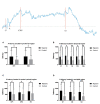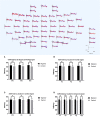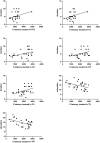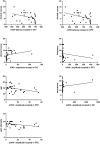Exploring the cortical habituation in migraine patients based on contingent negative variation
- PMID: 37719755
- PMCID: PMC10502328
- DOI: 10.3389/fneur.2023.1226554
Exploring the cortical habituation in migraine patients based on contingent negative variation
Abstract
Introduction: Cognitive dysfunction has frequently been found in patients with migraine. The so-called contingent negative variation (CNV) and EEG power spectral densities may be the best choices to explore the underlining pathophysiology, such as cortical inhibition and habituation.
Methods: Thirty migraine patients without aura and healthy controls matched for sex, age, and education were recruited separately for CNV recording. The amplitudes, latencies, and squares of different CNV components, such as oCNV, iCNV, tCNV, and PINV, were selected and analyzed. Behavioral data, such as manual reaction time (RT), were analyzed. We used the Person correlation coefficient R to analyze different ERP components in relation to clinical characteristics. A multiple regression analysis was conducted for the migraine group. Spectral analysis of EEG data from all channels using the fast Fourier transform (FFT).
Results: The migraine group had longer A-latency, C-latency, and iCNV-latency than the control group. The migraine group had higher iCNV-amplitude, oCNV-amplitude, and tCNV-amplitude than the control group, especially those located in the occipital area. The iCNV-square, oCNV-square, tCNV-square, or PINV-square in the migraine group was significantly larger than the control group. Different correlations were found between clinical characteristics and ERP components. The delta or theta activity in the migraine group was statistically lower than in the control group.
Discussion: Our study has revealed that migraine attacks may influence responsivity, pre-activation, habituation, and cortical inhibition not only on the behavioral level but also on the electrophysiological level. Abnormal changes in cortical habituation and inhibition can be interpreted as CNV components. Additionally, analyses have revealed correlations between CNV components and various factors, including age, the clinical course of the condition, attack frequency, pain intensity, and duration. Thus, repetitive migraine attacks can lead to a reduction in cortical inhibition and subsequent impairment in executive function.
Keywords: FFT (fast Fourier transform); contingent negative variation (CNV); cortical habituation; event-related potential (ERP); migraine.
Copyright © 2023 Ning, Zhang, Wang, Liu, Cheng, Zhu, Dong, Yang and Lv.
Conflict of interest statement
The authors declare that the research was conducted in the absence of any commercial or financial relationships that could be construed as a potential conflict of interest.
Figures











References
LinkOut - more resources
Full Text Sources
Miscellaneous

